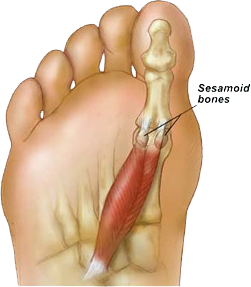Sesamoiditis
 Sesamoids are two small bones underneath the 1st metatarsal. They are located just behind the big toe that is connected to muscles by tendons. Sesamoiditis is a common ailment of the plantar forefoot, occurring when the tendons attaching to sesamoids become inflamed.
Sesamoids are two small bones underneath the 1st metatarsal. They are located just behind the big toe that is connected to muscles by tendons. Sesamoiditis is a common ailment of the plantar forefoot, occurring when the tendons attaching to sesamoids become inflamed.
These sesamoid bones are very similar to the kneecap. Therefore, acting to increase the leverage of the tendons. And, these tendons control the big toe. However, because of their location and function, they receive massive pressure every time the big toe is used to push the foot forward.
Sesamoiditis is commonly caused by a direct injury or repetitive stress to a sesamoid bone. It is often painful because of the constant pressure placed upon the injured bone. Athletes and people who engage in activities that subject the ball of the foot to extreme force are at a higher risk, though.
The tendons that connect the sesamoids to muscles can also become inflamed. This is due to repeated trauma, such as wearing high heels or inadequate footwear.
Sesamoiditis Symptoms
Sesamoiditis symptoms develop gradually. However, it starts as a mild ache with the intensity increasing while slowly becoming severe. Additionally, there is also a very uncomfortable throbbing. Sesamoiditis pain develops under the ball of the foot, and patients often notice bruising or swelling.
People with sesamoiditis also experience pain when moving the big toe. Plus, difficulties in bending or straightening the big toe. Sometimes, a pop sensation in the big toe when walking also occurs.
If you suspect that you are experiencing sesamoiditis, schedule an appointment online to visit our lead podiatrists in South Florida.
Sesamoiditis Treatment
As stated by Dr. MacGill, early diagnosis and prompt treatment of a sesamoid injury are critical. Therefore, leading to a successful treatment, faster and healthy recovery, and a pain-free lifestyle.
Sesamoiditis treatment will typically involve a conservative approach, involving resting from activities that are likely to aggravate the condition. Additionally, other options involving ice therapy, anti-inflammatory medications, and immobilization strapping are common.
Orthotics, such as padded insoles for your shoes are common. For mild cases, however, an over-the-counter orthotic insole will be helpful. In fact, there are orthotics available that are customized for your exact foot! And they are very beneficial in slowing the progress of the condition and preventing future injury to the area.
Sesamoiditis Surgery
If conservative treatments are unsuccessful or for severe cases ( such as a sesamoids fracture), surgery is often required. Therefore, removing the damaged or fragmented sesamoid bone(s). The procedure commonly involves a small incision on the side or the bottom of the big toe.
For an award-winning foot & ankle surgeon in Broward or Palm Beach County, call us today at 954-906-9272. Or schedule an appointment online now. Our top South Florida foot doctor is located in Boca Raton, Deerfield Beach, Coral Springs & Plantation.
